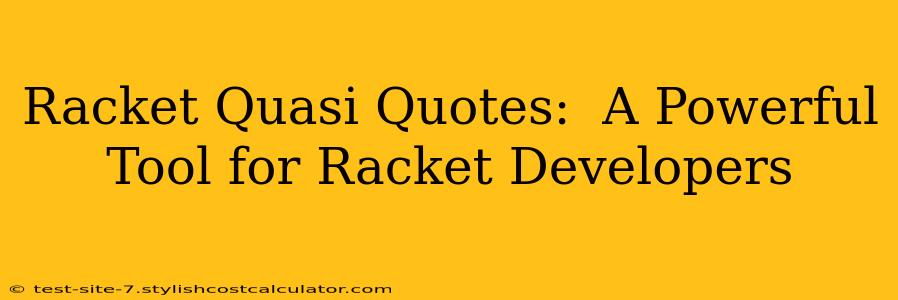Racket's quasiquote system is a powerful feature often overlooked by beginning programmers. It's a metaprogramming technique that allows you to manipulate code as data, enabling concise and elegant solutions to complex problems. Understanding quasiquotes unlocks a new level of control and expressiveness within the Racket language. This article delves into the intricacies of Racket quasiquotes, explaining their functionality, showcasing practical examples, and addressing common questions.
What are Racket Quasiquotes?
Quasiquotes, denoted by the backtick character () and the comma (,) and unquote-splicing (`,@), provide a way to embed expressions within code templates. Think of them as a sophisticated form of string interpolation, but instead of interpolating strings, you're interpolating Racket expressions directly into other Racket code. This allows you to generate code dynamically, making it incredibly useful for tasks like code generation, macros, and domain-specific language (DSL) creation.
The core components are:
-
Backtick (`): The backtick signifies the start of a quasiquote. Everything within the backticks is treated as a code template.
-
Comma (
,): The comma introduces an expression that will be evaluated and its result inserted into the code template. -
Unquote-splicing (
,@): Similar to the comma, but instead of inserting the result it inserts the elements of a list (or sequence) into the template.
How do Quasiquotes Work?
Let's illustrate with a simple example. Suppose you want to create a function that generates addition functions:
(define (make-adder n)
`(lambda (x) (+ x ,n)))
(define add5 (make-adder 5))
(add5 10) ; Output: 15
Here, make-adder uses a quasiquote. The expression (+ x ,n) within the backticks is a template. The comma before n signifies that the value of n (passed to make-adder) will be inserted into the template at that point. The result is a lambda function that adds its argument to the value of n.
What are the differences between , and ,@?
This is a crucial distinction. The comma (,) substitutes a single value into the template, whereas the unquote-splice (,@) substitutes the elements of a list or sequence. Let's examine:
(define my-list '(1 2 3))
`(list 0 ,my-list 4) ; Output: '(list 0 '(1 2 3) 4)
`(list 0 ,@my-list 4) ; Output: '(list 0 1 2 3 4)
Notice how , inserts the list itself as an element, while ,@ inserts each element of the list individually.
How are Quasiquotes Used in Macros?
Quasiquotes are fundamental to writing macros in Racket. Macros allow you to extend the language by creating new syntax. Quasiquotes are used to generate the code that implements this new syntax.
(define-syntax-rule (my-loop i n body ...)
(let loop ([i i])
(when (< i n)
body ...
(loop (+ i 1)))))
(my-loop i 5 (printf "~a\n" i)) ; Output: prints 0, 1, 2, 3, 4
Here, define-syntax-rule uses quasiquotes to create the code for the my-loop macro.
Can I use Quasiquotes with other data structures besides lists?
Yes! While lists are frequently used, quasiquotes work with other data structures like vectors and strings. The comma will substitute a value into the respective position within the structure.
Are there any performance considerations when using quasiquotes?
The performance impact of quasiquotes is generally minimal, especially for reasonably sized templates. However, overuse of extremely complex quasiquote expressions might lead to slight performance degradation. For most applications, this is not a significant concern.
Conclusion
Racket's quasiquote system is a powerful tool that empowers developers to write more expressive and concise code. Mastering quasiquotes opens doors to sophisticated metaprogramming techniques, enabling the creation of flexible macros, elegant code generation, and custom DSLs. While it may have a steeper initial learning curve, the benefits significantly outweigh the effort invested in understanding this critical Racket feature. By understanding the nuances between , and ,@ and their application in macro definitions, you’ll be well on your way to harnessing the true power of Racket's quasiquote system.

